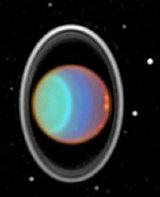
Uranus

Uranus is the seventh planet from the Sun. It is the third largest of the gas giants, although less than half the diameter of Saturn. One feature which puts the planet in a class of its own is the tilt of its rotational axis at 98 deg to its orbital plane. Uranus has five main satellites orbiting in the plane of its equator. The largest is Oberon with a diameter of 1,630km, Titania (1,600km), Ariel (1,330km), Umbriel (1,110km) and Miranda, a mere few hundred km across.
Composition Like Saturn, Uranus possesses a ring system. They have a completely different appearance however, being black as coal and are considerably thinner than Saturn's. Minor moons have been discovered on either side of the outermost rings, and perform a shepherding action similar to that seen in the Saturnian ring system.
Due to its great distance from the Sun, and the fact that it has very little internal heating, the planet's temperature is very low. At the top of the atmosphere the temperature is so low that methane condenses above the clouds. There is a considerable magnetic field around the planet which is offset from the centre, and is inclined at 60 deg to the rotational axis. This magnetic field extends far out into space and envelopes all the Uranian satellites.
Probes to Uranus Little was known about Uranus until its encounter with Voyager 2 in 1986. Voyager was able to return to Earth highly detailed images of each of the major satellites, and also revealed the presence of ten which were previously unknown.